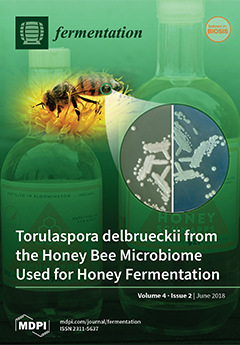Vineyards in Nemea, the most important viticultural zone in Greece, were surveyed for indigenous non-
Saccharomyces (NS) yeasts of enological potential. NS populations were isolated from the final stage of alcoholic fermentation and identified by a range of molecular methods. The enological profiles
[...] Read more.
Vineyards in Nemea, the most important viticultural zone in Greece, were surveyed for indigenous non-
Saccharomyces (NS) yeasts of enological potential. NS populations were isolated from the final stage of alcoholic fermentation and identified by a range of molecular methods. The enological profiles of
Hanseniaspora guilliermondii,
H. osmophila,
Lachancea thermotolerans,
Starmerella bacillaris and
Torulaspora delbrueckii strains were evaluated. Significant interspecies variation was observed in fermentation kinetics.
H. osmophila and
T. delbrueckii showed the highest capacity for prompt initiation of fermentation, while
S. bacillaris achieved a higher fermentation rate in the second half of the process. Significant differences were also observed in the chemical parameters of NS strains.
S. bacillaris SbS42 and
T. delbrueckii TdS45 were further evaluated in mixed-culture fermentations with
Saccharomyces cerevisiae. NS strains achieved lower population densities than
S. cerevisiae. SbS42 exhibited a higher death rate than TdS45. The chemical profiles of different ferments were separated by principal component analysis (PCA). Both NS strains were associated with lower levels of ethanol, when compared to single
S. cerevisiae inoculation. TdS45 increased the ethyl acetate levels, while SbS42 caused a different production pattern of higher alcohols. This is the first report to explore the enological potential of NS wine yeast populations from Nemea. Based on prominent enological traits identified, the selected
S. bacillaris and
T. delbrueckii strains may be further exploited as co-culture starters for improving the quality and enhancing the regional character of local wines.
Full article





